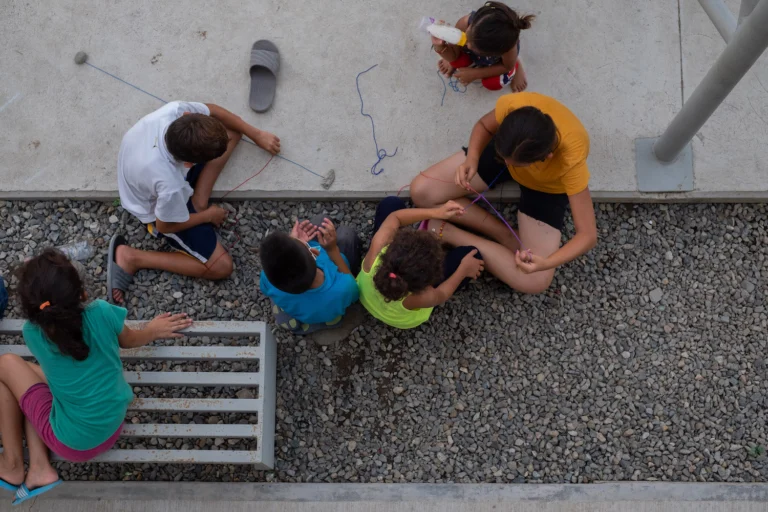Migration Policies and Children’s Rights: The Case of Venezuelan Children in the United States

Children play basketball at the Hospitalidad y Solidaridad shelter in the southern city of Tapachula, during a visit by Deputy High Commissioner Kelly Clements. The shelter, Mexico’s first shelter exclusively for refugees and asylum-seekers, was financed by UNHCR and has a capacity of up to 300 people. ; During an extended mission to Honduras, Guatemala and Mexico in May, Deputy High Commissioner Kelly Clements met people forced to flee, heard about the risks families faced and learned how, once safe, many have begun to rebuild their lives. During her trip, she met government officials, civil society partners and business leaders with whom UNHCR has joined forces to find ways to help displaced people.
July 4, 2025 Hour: 1:00 pm
The Venezuelan migration crisis is one of the most significant in recent history. Tens of thousands of Venezuelans have undertaken dangerous journeys in search of better conditions, facing restrictive U.S. immigration policies that have led to family separations and left children in extreme vulnerability.
This article examines the stories of separated families, the legal framework, and complaints about the treatment of migrant children, as well as the Venezuelan government’s stance on this humanitarian crisis.
Stories of Separation at the Border
Talimar Machado, a Venezuelan mother, recounts how her five-month-old daughter was taken from her at a migrant center in California.
After just three days at the center, unidentified individuals took the child. Talimar was transferred to another facility, where she was only told that her daughter was with a temporary family.
She spent ten months without further details and returned to Venezuela in May 2025, still without additional information about her daughter, who now lives in South Carolina.
This is just one of many stories of mothers and grandmothers pleading for the return of their children and grandchildren. Children between the ages of one and twelve remain in the custody of temporary families in the U.S., some passing through up to five different homes without being reunited with their biological families.
The Context of Venezuelan Migration
The political and economic situation in Venezuela has driven thousands of families to migrate. The United States is a primary destination for many Venezuelans, who have undertaken unimaginable journeys to get there.
However, U.S. immigration policies have grown stricter, particularly under the administration of Donald Trump, who implemented anti-immigrant measures. Currently, surveillance and enforcement have intensified against migrants from Venezuela, Cuba, Haiti, and Nicaragua.
The Venezuelan crisis, once marked by hyperinflation, food shortages, and unilateral U.S. sanctions, forced many families to leave. The route to the U.S. involves crossing at least seven countries and navigating critical points such as the Colombia-Venezuela border, the Darién Gap, and the U.S.-Mexico border.
Many travel with children and elderly relatives, facing deadly risks, abuse, and exploitation. International organizations have denounced the rising number of disappearances and deaths along these routes.
U.S. Immigration Policies and Their Impact on Children
The Immigration and Nationality Act (INA) of 1952, amended multiple times, regulates the admission, exclusion, deportation, and naturalization of foreigners in the U.S.
The Immigration Act of 1990 increased legal immigration limits and authorized Temporary Protected Status (TPS) for citizens of crisis-stricken countries, including Venezuela. However, in 2025, executive orders were implemented that tightened TPS requirements and restricted humanitarian parole.
Laws Protecting Minors
The INA defines a minor as an unmarried person under 21 and establishes special procedures for their protection. It includes the Child Status Protection Act (CSPA), which prevents minors from aging out during immigration processes. Unaccompanied minors are referred to theOffice of Refugee Resettlement (ORR), responsible for their custody and finding legal sponsors.
Conditions in Migrant Detention Centers
Human rights organizations have denounced the inadequate care children receive in these centers. Reports highlight negligence, frequent illnesses, lack of healthcare access, overcrowding, unsanitary conditions, and insufficient food.
Prolonged detention, isolation, and uncertainty generate high levels of stress, anxiety, depression, and suicidal thoughts among children. Some minors have been detained for weeks without access to sunlight or recreational activities, worsening their mental health.
Changes in Recent Years
During Donald Trump’s first presidency, the “zero-tolerance policy” was implemented, which involved criminally prosecuting all migrants who crossed the border irregularly.
Parents were detained in federal prisons, while their children, classified as unaccompanied, were transferred to ORR custody, physically separating families. This policy triggered a humanitarian crisis and widespread international condemnation. Although suspended in June 2018, it had already separated around 5,500 children from their families. Many remain unreunited.
In 2023, a court settlement banned intentional family separation for at least eight years and established measures to identify, reunite, and provide legal and social assistance to affected families.
However, the Trump administration maintains strict controls and unannounced visits to migrant children’s homes, generating fear and confusion, often leading to the detention and deportation of relatives, leaving children without family support. Family separations continue under various legal pretexts.
What Happens to Children Separated from Their Families?
When the U.S. government separates migrant children from their families, they are placed in ORR custody while authorities seek a legal sponsor. Some are placed in temporary homes, but uncertainty and bureaucratic hurdles delay family reunification.
Separation and instability increase emotional vulnerability and hinder children’s resilience, causing psychological harm that affects their immediate and long-term well-being.
Legal and Human Rights Perspectives
In 1989, the United Nations adopted theConvention on the Rights of the Child (CRC), establishing a legal framework for the comprehensive protection of all children under 18.
Article 22 of the CRC requires states to protect and assist refugee children, cooperate in locating their families, and facilitate reunification.
In 1997, the Flores Settlement Agreement was established, regulating the treatment, detention, and release of migrant minors in the U.S. The Trump administration attempted to modify this agreement to ease restrictions on prolonged child detention.
The UN’s Stance
The UN and the Office of the High Commissioner for Human Rights have expressed concern over arbitrary detention, lack of due process, deportations without legal recourse, and missing information on the whereabouts of children and their families.
They denounce detention conditions and expulsions as violations of fundamental rights, endangering minors’ physical and psychological integrity. Reports from UN agencies and child rights organizations warn of prolonged detention, family separation, lack of legal representation, education, healthcare, and psychological support.
Detention of Venezuelan Children and the Venezuelan Government’s Response
The Venezuelan government, led by Nicolás Maduro, has strongly denounced the detention and separation of Venezuelan children in the U.S., calling it “kidnapping” and “child theft.”
They demand the immediate repatriation of at least 18 children, aged one to twelve, who remain in U.S. custody after their parents were deported. Some were separated even after their parents were sent to maximum-security prisons, such as CECOT in El Salvador, preventing family reunification.
Interior Minister Diosdado Cabello accused the U.S. government of promoting the theft of Venezuelan migrant children, claiming more minors are “kidnapped” than officially acknowledged.
National Assembly President Jorge Rodríguez called the situation a barbarity and requested Vatican mediation for the children’s recovery, criticizing the UN’s inaction.
Venezuela has launched a diplomatic and legal campaign in multilateral forums to demand the children’s return and denounce U.S. immigration policies as violations of international law and treaties like the CRC.
Evidence Presented by the Venezuelan Government
Venezuela has submitted testimonies from relatives describing how children were taken without clear explanation or reunification guarantees. The government interprets this as kidnapping by U.S, authorities and has vowed to use all international mechanisms to demand repatriation, despite some organizations’ lack of response.
Urgency in Protecting and Repatriating Venezuelan Migrant Children
The situation of Venezuelan migrant children in the U.S. is extremely grave and requires immediate attention, particularly the urgent repatriation of the 18 separated minors, who face risks of abuse, exploitation, and trafficking.
Despite existing laws protecting their rights, these guarantees are not being upheld, exposing these children to constant human rights violations and potential long-term harm.
Author: Silvana Solano
Source: TeleSUR




